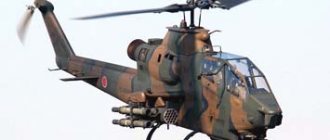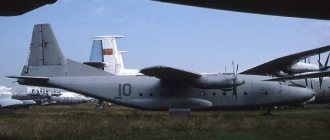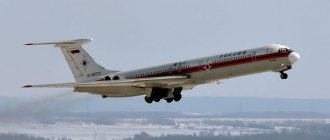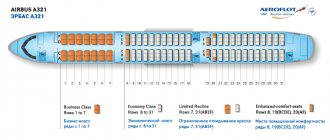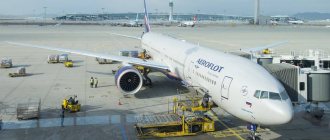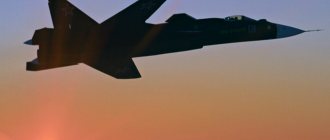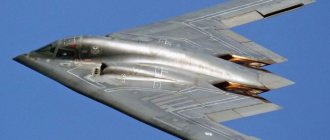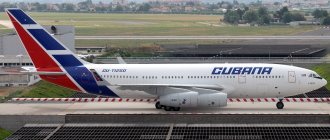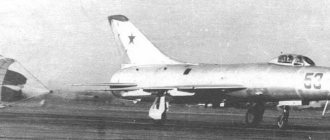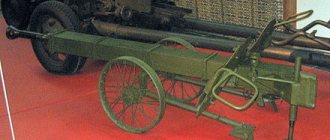| Bell P-39 Airacobra | |
| Mechanics launch a P-39Q-1-BE "Saga Boy II" belonging to the commander of the 357th Fighter Group, Hamilton AFB, California, July 1943. | |
| Type | fighter |
| Developer | Bell Aircraft |
| Manufacturer | (Buffalo) |
| Chief designer | Robert Woods |
| First flight | April 6, 1939 |
| Start of operation | January 1941 |
| End of operation | early 1950s (USSR) |
| Status | not in use |
| Operators | US Air Force USSR Air Force Royal Air Force |
| Years of production | 1940 - September 1944 |
| Units produced | 9584[1] |
| Unit cost | US$50,666 in 1944[2] |
| Options | Bell XFL-1 Airabonita Bell P-63 Kingcobra |
| Media files on Wikimedia Commons | |
This term has other meanings, see R-39 (meanings).
Bell P-39 Airacobra
(English: Bell P-39 Airacobra) - an American fighter of the Second World War, distinguished by an unusual design for its time (the engine was located behind the cockpit and was connected to the propeller by a long shaft).
Half of all aircraft produced (more than 4,500 units) were delivered to the USSR under Lend-Lease[3]. The most successful aces flew on the P-39, such as Alexander Pokryshkin, Grigory Rechkalov, Alexander Klubov, Nikolai Gulaev[4], brothers Dmitry and Boris Glinka.
It was in service with five countries: the USA, Great Britain, the USSR, Portugal and Australia. A further development of the P-39 design was the P-63 fighter.
Internal layout.
Content
- 1 History of creation
- 2 Construction 2.1 Fuselage
- 2.2 Powerplant
- 2.3 Booking
- 2.4 Armament
- 3.1 P-39C (factory designation: Model 13 and Model 14)
- 7.1 Feedback from pilots
History of creation[ | ]
The Airacobra is the first production car (Buffalo, New York, USA). The following took part in the development: Lawrence D. Bell - the head of the company, Robert D. Woods - the chief designer, and his assistant - Garland M. Poyer.
The history of the machine's creation dates back to 1935, when Woods attended a demonstration organized by American Armament of the new 37-mm automatic aircraft gun Oldsmobile T9, later adopted as [en]. Woods really liked this gun, and he had the idea to put it on a single-engine fighter.
In 1936, the US Air Force organized a competition to develop preliminary fighter designs for subsequent consideration. The Model 3 project was based on a combination of a motor mount with an extended shaft and a 37 mm gun. A cantilever monoplane design, common to all new-generation fighters, was chosen, but the Allison V-1710 engine was located at the trailing edge of the wing. The transmission shaft, about 3 m long, ran along the bottom of the fuselage, having the same rotation speed as the Allison crankshaft.
On May 18, 1937, the Model 4 project was sent for review to the headquarters of the US Air Corps. The discussion of the project lasted more than four months, and as a result, on October 7, the development company received a contract for the construction of a prototype under the designation “XP-39”.
On December 29, 1938, the disassembled vehicle arrived by rail at the test center (Wright Field, Ohio). Rework and fine-tuning of the vehicle continued until February 8, 1939, when it was possible to start the aircraft engine. But after the first taxiing (March 1, 1939), due to deficiencies in the cooling system, the engine had to be dismantled.
Assembly of the prototype was completed in March 1939, nine months late, while the weapons on the XP-39 were missing along with some military equipment.
The first flight took place on April 6, 1939 (pilot James Taylor), without weapons and armor, the plane reached a speed of 628 km/h with a flight weight of 2.5 tons (according to other sources, 603 km/h at 2768 kg). Even before the end of flight testing on April 27, 1939, the US Army and Bell entered into a contract for the construction of the first series of 13 units under the designation YP-39.
The aircraft was extensively tested by the National Advisory Committee for Aeronautics (NACA). At the same time, the desire of the military was to use the Airacobra with its powerful weapons at low and medium altitudes as a front-line fighter, which forced the designers to significantly change the appearance of the aircraft. It was decided to remove the turbocharger, and the new project “model 12” received a V-1710-39 engine with a maximum power of 1090 hp. pp., optimized for medium heights.
On November 25, the XP-39B, which became almost 100 kg heavier than the XP39, began flight tests. Design alterations led to the fact that the maximum speed of the aircraft decreased to 624 km/h, the rate of climb worsened (6100 m in 5 minutes versus 7.5 for the XP-39), but the changes had virtually no effect on the behavior of the aircraft at low altitudes.
The history of the creation of the P-39 Airacobra fighter
The history of the P-39 Airacobra fighter began in 1936, when, under the leadership of R. Wood and H. Poyer, the Model 3 aircraft project was created. A feature of the project was the installation of the engine not in front, but at the center of mass of the fuselage, with the propeller driven through a long shaft. This arrangement made it possible, firstly, to improve the maneuverability of the aircraft, and secondly, to place more powerful weapons in the nose.
The Model 3 had a big drawback - the pilot was located behind the engine and had poor visibility from the cockpit. Then the design was redesigned and the cabin was moved forward, calling the project “Model 4”. It was this project that interested the Army Air Corps; on October 7, 1937, the company received an order for the production of a prototype under the designation XP-39.
In 1938, the unusual fighter passed tests surprisingly easily (albeit with modifications) and was recommended for production under the designation P-39 “Airacobra” (originally the P-45). The American Air Force thus received not only the most “extravagant” US combat aircraft of the Second World War, but also the most powerful one - it’s no joke, to have it already in the late 1930s. a fighter whose “main caliber” is not the usual 2-6 7.62 mm machine guns, but 2 x 12.7 mm machine guns and 1 x 37 mm cannon!
P-39 Airacobra fighter
Production of the P-39 continued until August 1944. A total of 9,558 aircraft of various modifications were manufactured. Of these, 4924 were delivered to the USSR. The modernized P-63 Kingcobra fighter was developed especially for the Red Army. The P-39 was in service in the United States until April 1944, Italy until June 1945, and France until 1947. In the USSR, some aircraft were operated until 1953.
Construction[ | ]
Fuselage[ | ]
The design is a single-seat, single-engine, all-metal cantilever monoplane with a low wing and a three-post landing gear. This fighter was distinguished by several unusual design solutions:
- Its engine was located behind the cockpit. This engineering solution gave the Airacobra a number of advantages: better maneuverability, aerodynamics, better visibility, the ability to accommodate heavier weapons, greater pilot protection, etc. The shaft from the engine to the propeller passed through the cockpit, between the pilot’s legs;
- “Car” type doors, which made boarding the plane easier, but made emergency exit from the plane dangerous.
The fuselage frame consisted of two power box spars along the entire length. An engine was placed in the middle of the fuselage, which was also used as a structural structural element. The cockpit, weapon carriages, gearbox and nose landing gear were attached to the spars. There was a fire partition between the engine and the cabin. The fuselage was covered with aluminum alloy sheets. For ease of maintenance, there were several easily removable panels that provided good access to the engine, weapons and aircraft equipment.
The aircraft cabin had good ergonomics. To enter the cabin there were two automobile-type doors, with the right one being operational, and the left one opening only from the outside and intended for access during an emergency landing. However, both doors could be reset during emergency escape. To heat the cabin and weapons compartment in winter, a gasoline stove was installed. To protect the pilot during an emergency landing, an anti-crash frame was installed.
The aircraft wing is three-spar. The spars are aluminum (except for the rear steel one). The casing is functional duralumin. The control surfaces are covered with canvas, the trimmers are plastic. Inside the wing there are protected (raw rubber) fuel tanks, on different modifications from 8 to 12.
The chassis is three-post, with a front wheel, a first for a fighter. Cleaning and release by electric drive, there was an emergency mechanical release system.
Engine in the Air Force Museum in Moscow
Powerplant[ | ]
The power unit consisted of a 12-cylinder V-shaped engine of the V-17I0 type, installed in the middle of the fuselage at the center of gravity of the aircraft, and a three-blade variable-pitch pulling propeller, type “Curtiss Electric” with a diameter of 3.16 m. The propeller could work as a propeller automatic and as a fixed pitch propeller, with electrically controlled rotation of the blades. The control of engine speed and propeller pitch was separate up to the P-39Q model, on which a single “step-throttle” handle and an Aeroproducts propeller with hydraulic control of the rotation of the blades were installed. On modifications Q-21 and Q-25 the propeller is four-blade.
The torque from the motor to the propeller was transmitted by a 3-meter long propeller shaft, consisting of two halves (to relieve loads on the bearings during fuselage deformations during maneuvering). To reduce shaft vibrations, a hydraulic damper was used.
The engine cooling system is liquid. The carburetor intake pipe was located behind the canopy on top, and the radiator air ducts were located in the wing root.
Booking[ | ]
The design provided for rear armored glass with a thickness of 63 mm. Front (mounted in the visor) - 37 mm. The pilot's armored back and the armor behind the engine, covering the oil tank, are steel, 6.5 mm thick. The mass of metal armor is 92 kg, the mass of armored glass is 27 kg[5].
Armament[ | ]
- 37-mm cannon (30 rounds of ammunition) or 20-mm HS-404 cannon (on the P-400 modification, 60 rounds of ammunition).
- 12.7 mm Browning M2 machine guns (ammo capacity 200-270 rounds per barrel), from two to four machine guns, depending on modification.
Description of the Yak-7 design
The Yak-7 is a single-seat, single-engine monoplane fighter with a low wing and a mixed design: both duralumin and wood with canvas were used in the manufacture of the machine. The plane's crew consisted of one person.
Like other fighters of the Yak family, the power frame of the Yak-7 was made of chromansil pipes, to the front of which a motor mount was attached. An advantageous difference between the Yak-7 and other Yakovlev aircraft was that the removable engine mount made it possible to install other engines on the aircraft. The skin of the front part of the fighter was metal, and the tail part of the Yak-7 was sheathed with plywood.
The pilot's cabin was located in the central part of the fuselage. The Yak-7 was created on the basis of the Yak-7UTI training aircraft, which had two cabins - for the pilot and the instructor. On a combat aircraft, the second cockpit was removed, and in its place was an additional compartment, closed with a lid. It could be used to carry cargo, another person, or install an additional gas tank.
The tail of the Yak-7 consisted of a wooden keel and stabilizer, the rudders were made of duralumin and covered with canvas. The aircraft had a tricycle retractable landing gear, which included two main struts and a tail support. On the first modifications of the machine, the tail wheel was not retracted in flight. Like other Yakovlev fighters, the Yak-7 had a landing gear with air-oil shock absorption; the landing gear was retracted and released using a pneumatic system. In the retracted position, the chassis was covered with flaps.
Initially, the Yak-7 fighter was equipped with a water-cooled M-105P engine (1050 hp), then more powerful engines were installed on the aircraft (M-105PA, M-105PF). The vehicle's fuel tanks were protected and located in the wings: two in the wing consoles and one more in the center section. The plane had an inert gas pumping system, which increased its fire safety.
The oil cooler was located in the front part of the fighter in a special tunnel under the engine, the water radiator was installed in the central part of the fuselage just behind the cockpit. In winter, antifreeze was added to the water, and gasoline was added to the oil.
The Yak-7UTI trainer had no weapons at all, the Yak-7 received a 20-mm ShVAK cannon, which was located in the engine camber, as well as two ShKAS machine guns (7.92 mm). The cannon's ammunition capacity was 130 shells, and that of the machine guns - 1,000 rounds. The modification of the Yak-7A aircraft could carry several rockets or 100 kg of bombs. The most widespread modification of the Yak-7B fighter was armed with one ShVAK cannon and two 12.7-mm UBS machine guns, which significantly increased the firepower of the vehicle. Combat reports noted that after the installation of more powerful UBS machine guns, the Yak-7 became effective against both air and ground targets.
In service[ | ]
The first Airacobra ordered by the US Air Force flew on September 13, 1940. Vehicles of this series received the designation YP-39 in the army. The weight of the aircraft with fully installed weapons and armor was already 3.3 tons, the fighter reached a speed of 592 km/h (at an altitude of 4600 m). The armament of this model consisted of a 37 mm Oldsmobile T-9 cannon (15 rounds), 2x12.7 mm machine guns and 2x7.62 mm machine guns (all machine guns installed in the forward fuselage).
P-39C (factory designation: Model 13 and Model 14)[ | ]
On August 10, 1939, USAAC (US Army Air Corps) ordered 80 aircraft. Deliveries of the first 20 vehicles began in January 1941.
The entire batch was equipped with V-1710-35 engines with a power of 1150 hp. With. with three-bladed Curtis Electric propellers type C6315SH-C2.
France ordered 200 kits (disassembled aircraft in a Model 14 shipping container) on October 8, 1939. Each set cost $44,982. However, France capitulated before the first box was shipped. The deal fell through.
On April 13, 1940, a contract was signed for the supply of a total of 675 vehicles to the UK, including 200 not sold to France. At the customer's request, the aircraft were modified and equipped with a V-1710-E4 engine. The planes had protected gas tanks of smaller capacity, a modified oxygen system, and 20-mm Hispano Mk.1 cannons.
About 170 fighters had been assembled when, in December 1941, the British Air Ministry decided to withdraw the Airacobra from service. In total, according to various estimates, from 80 to 100 aircraft were assembled and flown, about 70 aircraft were used by the British for their intended purpose, the rest were simply not unpacked. The British sent 212 Airacobras to the USSR in the form of assistance, of which 54 were lost along with their ships as a result of attacks on convoys.
Bell P-39F-1-BE Airacobra
P-39D[ | ]
The remaining 60 vehicles were completed according to a modified design - additional armor was installed, a 37-mm cannon with 30 rounds of ammunition, and 7.62-mm machine guns were moved from the fuselage to the wing, their number reached 4, the tanks were made protected, which is why they were the volume decreased to 454 liters, and it was necessary to provide for the possibility of attaching an external tank with a capacity of 290 liters (or a bomb - 272 kg). Engine V-1710-35 (E5) 1150 hp. With. The first vehicles of this series began to arrive in combat units in April 1941. In September 1941, in addition to these 60 aircraft, another 369 aircraft were ordered.
"Airacobra"[ | ]
The British Arms Procurement Commission ordered 675 Bell Model 14 vehicles on April 13, 1940. The contract stated that the maximum speed should be 644 km/h, the operating ceiling should be 11,000 m, and the flight range should be more than 1,600 km. The contract data was based on the characteristics of the experimental YP-39 prototype. These requirements were met only on the modified machine with serial number AH571. In mass products released with the P400 index (serial numbers AH570-AH739), these requirements were not met. It was planned to supply 150 aircraft under lend-lease in 1941, but in practice the British Air Force received only two aircraft. This modification for the British Air Force was called the “Airacobra” and had different weapons from the American version: a 20-mm British Hispano Mk.404 cannon (60 rounds) and a 4x7.62-mm machine gun in the wings or English 7.69 mm machine guns "Browning".
On October 9, 1941, the British Airacobras flew their first and only combat attack mission. Already in December 1941, the aircraft was withdrawn from service with the Royal Air Force, as the British aviation industry began producing more advanced aircraft of its own design.
P-39D-1[ | ]
The basis for its creation was the Airacobra I; the company designated the car as the Bell Model 14A. The shortage of 37-mm cannons led to the installation of a 20-mm cannon (60 rounds) Hispano-Suiza Mk 404 on the vehicle. The engine was able to briefly boost (5 minutes at an altitude of more than 1300 m) to 1490 hp. With. Take-off weight - 3528 kg. Climb 1500 m in 2 minutes 34 seconds. The turning radius is 234 m. During diving tests, a speed of 805 km/h was achieved. Flight range with an additional fuel tank of 600 liters is 2700 km.
P-39D-2[ | ]
The construction order was signed on September 17, 1941. In-house model designation "Bell Model 14A-1". 158 vehicles were built. Powerplant - Ellison V-1710-63 (1325 hp); the engine ran only on 100-octane gasoline. About 900 vehicles were built of all “D” modifications (D-2 and D-3).
P-39F[ | ]
On September 13, 1940, a contract was signed for the construction of 254 vehicles. The in-house model designation is “Bell Model 15B.” General Motors Aeroproducts Hydromatic Propeller - 3.14 m.
Bell P-39Q Airacobra, Pavel Iosifovich Chepinoga 508th Fighter Aviation Regiment, autumn 1944
"Airacobra" in the USSR[ | ]
It should be pointed out that the start of deliveries of the Airacobra to the USSR was due to its low demand in the Western theaters of war, where the advantages of this fighter could not be fully realized. Almost all air battles took place here at high altitudes, where the Airacobra was inferior to other aircraft. Therefore, the popularity of the machine among Soviet pilots was somewhat unexpected, however, after the Soviet Union began to purposefully demand continued supplies of the Airacobra in ever larger quantities, production of more and more new models of this fighter began specifically for the needs of the Eastern Front[6].
In total, 4952 P-39 Airacobra fighters were delivered to the USSR under Lend-Lease, which is approximately half of the total number of vehicles produced[7]. Since December 1941, Great Britain sent 212 P-39 aircraft to the USSR; in 1941, the USSR received only one aircraft, in 1942 - 192. Delivery of these early models was completed in January 1943. All vehicles arrived mainly to the 22nd reserve aviation regiment of the 6th reserve aviation brigade. The regiment consisted of four assembly brigades and three aviation training squadrons (one each for Kittyhawks, Hurricanes and Airacobras). In addition to the supply of aircraft under Lend-Lease, more than a million shells were supplied for the 37-mm aircraft cannon (English)Russian, with which the Airacobra was armed. The first regiment retrained for the new aircraft was the 153rd Fighter Aviation Regiment, which completed training on June 14, 1942 and was redeployed to the Voronezh Front, where it arrived on June 29. During 3 months of fighting, the regiment destroyed 18 bombers, 45 fighters, its own losses - three pilots, 8 aircraft, and was awarded the title of Guards (28th Guards Fighter Aviation Regiment).
For the first time in the Great Patriotic War, the Airacobra entered battle on May 16, 1942, as part of the 19th Guards Fighter Aviation Regiment (16 vehicles) in the Arctic.
Among the famous Soviet aces, Amet-Khan Sultan, G. Rechkalov, N. Gulaev, V. Fadeev, P. Kutakhov (who later became an air marshal and deputy minister of defense of the USSR) fought on the P-39. Three times Hero of the Soviet Union A.I. Pokryshkin, who also flew the Airacobra, won 48 of his 59 aerial victories on this aircraft, and 11 of the 27 fighter pilots twice Heroes of the Soviet Union fought on it[8]. Soviet pilots called the Airacobra: “Bella”, “Bellochka”, after the name of the manufacturer of this aircraft - “Bell Aircraft Corporation”[9].
As already mentioned, Western pilots greeted the Airacobra with reserve, since they, as a rule, fought at high altitudes, where this aircraft was inferior to other fighters. To a large extent, precisely because the Airacobra was considered a low-value machine, they began to supply it to the USSR, preserving the best fighter models for their pilots.
However, on the Soviet-German front, the positive qualities of this aircraft were fully demonstrated, namely: high speed and maneuverability at medium and low altitudes, where, unlike the Western allies, Soviet fighter aircraft mainly operated. For this reason, Soviet pilots highly appreciated the flying qualities of the Airacobra, despite a number of serious shortcomings.
In the ranks of the Red Army
As part of the Air Force of the Red Army on the battlefields of the Great Patriotic War, the Airacobra received its baptism of fire on May 16, 1942 on the Karelian Front in the Arctic (19th Guards Fighter Aviation Regiment).
The difficulties that Soviet pilots and technical personnel had previously encountered when using other Allied aircraft (for example, the Hurricane) supplied under Lend-Lease were taken into account. That is why it was decided not to immediately supply the Airacobra to the active army. There were two reasons for this decision. The first reason was the need to better study the aircraft and prepare it for the specific conditions of a given theater of military operations. Indeed, in the first months after the start of aircraft deliveries to the Soviet Union, many large aviation institutes worked on the Airacobra.
The second, no less important reason was the rather “capricious” behavior of the fighter on turns or when performing aerobatics
That is why the training of pilots on the P-39 should have been given exceptional attention
The first regiment fully equipped only with Airacobra fighters was the 153rd Fighter Aviation Regiment, which operated as part of the Voronezh Front. It is the battle for Voronezh that is one of the most heroic pages in the history of the P-39. So, in just three months of fighting, from the end of June to the end of September 1942, in the midst of fierce battles with Nazi troops trying to occupy Voronezh, the 153rd regiment destroyed over 60 enemy vehicles, losing no more than 10 vehicles. For its high merits, the regiment was awarded the title of Guards (renamed the 28th Guards Fighter Aviation Regiment).
It is worth noting that it was on the fronts of the Great Patriotic War that all the advantages of the Airacobra were fully revealed. This was largely due to the fact that Soviet pilots, unlike their Western colleagues, preferred to conduct air battles mainly at medium and low altitudes, for which the fighter was intended. That is why, and also because the second most successful Soviet ace Alexander Ivanovich Pokryshkin flew on the P-39, the plane earned the well-deserved love of Soviet pilots.
Performance characteristics[ | ]
The characteristics obtained during testing of the P-39D
in USSR.
Bell P-39D Airacobra Bell P-39 Aircobra.
Night shooting “from all barrels” Data source: Bakursky, 1991, p. 6; Kotelnikov, 2009, pp. 38-44.
Specifications
- Crew: 1 (pilot)
- Length: 9.159 m with gun:
9.58 m
: 5,35
3.04 m
3.454 m
455 l
(1 × 846 kW)
- Propeller: Curtiss three-blade
- Screw diameter: 3.16 m
Flight characteristics
- Maximum speed: ground:
493 km/h - at altitude:
585 by 4200 m
145 km/h
3.65 hours
19 s / 253 m
Armament
- Rifle-cannon: 1 × 37 mm M4 cannon with 30 rounds or
- 1 × 20 mm M1 cannon with 60 rounds (D-1, D-2)
- 2 × 12.7 mm machine guns, 270 rounds each. (on D-2 200) each in the forward fuselage
- 4 × 7.62 mm machine guns, 1000 rounds each. everyone in the wing
World Of Man Dreams
Developer: Bell Country: USA First flight: 1940 Type: Fighter
At the end of the 1930s. American aircraft manufacturing companies, taking advantage of the end of the economic crisis, began to produce a lot of original designs and, oddly enough, some of them were even brought to the stage of mass production. At the forefront of these endeavors was a young but very ambitious company Bell Aircraft Corporation, which distinguished itself in 1937 with the YFM-1 "Airacuda" twin-engine cannon fighter.
Even during the testing of its first aircraft, Bell, in the same year, proposed to the USAAC command a project of no less than an original single-engine fighter. In fact, the design of the aircraft was built around the Oldsmobile T9 37 mm cannon. With a relatively low rate of fire, this weapon had high destructive power and was a very effective weapon against bombers. It had previously been planned for installation on the Lockheed P-38 fighter, but it was heavy, expensive and difficult to manufacture, and USAAC wanted something cheaper.
Accordingly, Bell specialists proposed a scheme with the power plant located in the middle part of the fuselage, and also developed an original transmission. In the vacated forward part of the fuselage, they decided to mount machine guns and a 37-mm cannon, which fired through the hollow propeller shaft. The cabin itself also contained many original solutions: the canopy was divided into several sections and provided excellent visibility, and boarding and disembarking were carried out through side doors with lifting side windows. In addition, for the first time on an American single-engine fighter, a tricycle landing gear with a nose wheel was used. The main struts together with the wheels were retracted into the center section, and the nose wheel was retracted into a niche in the front part of the fuselage. The prototype was equipped with an Allison V-1710-17 in-line engine with a power of 1050 hp. with a liquid cooling system and a General Electric B-5 turbocharger, since the fighter was expected to be used at high altitudes. On the left side there was a large air intake with a fairing covering the turbocharger, and on the right side there was a smaller air intake for the oil and water cooler.
Contract for the construction of the first prototype, designated XP-39 “Airacobra”
, was received very quickly - on October 7, 1937, and on April 6, 1938 it made its first flight.
The public demonstration of the aircraft took place on February 9, 1939. The fighter made a favorable impression on USAAC representatives and on April 27 a contract was signed for the supply of an initial series of 12 YP-39A
. In addition, the military could not immediately decide which fighter they needed more - for operations at high or low altitudes. To provide for both options, one pre-production aircraft had to be equipped with an Allison V-1710-37 engine, but without a turbocharger. It is worth making a note here that the XP-39 flew with armor and weapons, the installation of which on the YP-39A led to an increase in take-off weight.
To compensate for the decrease in flight data, the XP-39 was submitted for testing at NACA, where, based on the test results, more than 60 design changes were made. In the final version, it was decided to get rid of the turbocharger and install an Allison V-1710-39 engine, designed for an altitude of 4054 meters. Accordingly, the placement of the air intakes was changed, the wing span was reduced, the cockpit glazing was redone and the fuselage was lengthened. The armament of the pre-production fighters consisted of one 37-mm T-9 cannon (15 rounds), two 7.62-mm (500 rounds per barrel) and two 12.7-mm machine guns (200 rounds per barrel) in the forward fuselage .
All fighters, after undergoing modifications, were transferred to USAAC during September-October 1940 for operational testing under the designation YB-39B
. Aerodynamics were indeed improved, but the abandonment of the turbocharger led to a decrease in speed characteristics at low and medium altitudes - for example, the fighter now reached an altitude of 6100 meters in 7.5 minutes. With an increase in take-off weight to 3282 kg, maneuverability improved, and the maximum speed was 592 km/h, which was the best indicator among similar American vehicles of a similar type.
However, the fate of this aircraft was decided on August 10, 1939, when the USAAC command signed a contract for the supply of 80 production fighters under the new designation P-45
, which soon had to be changed to
R-39C
, so as not to create the appearance of creating a completely new aircraft.
The production model was largely similar to the YP-39B. The first aircraft of this modification (40-2971) took off in January 1941, but almost immediately several new modifications were made to the design, which was a consequence of reports of combat operations from Europe. As a result, only 20 R-39C aircraft were built, after which production of other modifications was launched.
Second production version, known as P-39D
was distinguished primarily by a modified composition of armament: four 7.62-mm machine guns were installed in pairs in each wing console, while maintaining a 37-mm cannon and two 12.7-mm machine guns in the forward part of the fuselage (the ammunition for the gun was increased to 30 shells). The aircraft was equipped with an Allison V-1710-35 engine with a power of 1150 hp, protected fuel tanks with a total capacity of 454 liters, additional armor for the pilot’s cabin and windproof glass. Compared to the P-39S, the take-off weight increased from 3257 to 3720 kg. The first order for 344 P-39Ds was received on September 13, 1939, and soon the remaining 60 P-39S were added to them, which they decided to develop into an updated version. During 1941-1942. The following modifications were mass-produced:
P-39D (Model 13)
– serial version on a base with armor increased in weight to 111 kg. The armament consisted of a 37 mm cannon (30 rounds), two 12.7 mm machine guns (200 rounds per barrel) and four 7.62 mm machine guns (1000 rounds per barrel). 60 aircraft were built.
P-39D-1 (Model 14A)
– production model with a 20 mm M1 cannon instead of a 37 mm cannon (serial numbers 44-128257 – 44-128406, 41-38220 – 44-138404 and 41-38563). 336 aircraft were built.
P-39D-2 (Model 14A-1)
– production model with engine V-1710-63 (E6) with a power of 1325 hp. and weapons, which again included a 37 mm cannon. Provision was made for mounting a 549-liter external fuel tank or a 227-kg bomb under the fuselage. 158 aircraft were built with serial numbers from 44-138405 to 44-138562.
P-39D-3
– a production model of a photo reconnaissance aircraft based on the D-1, equipped with K-24 and K-25 photo cameras in the rear of the fuselage and additional armor for oil coolers. 26 aircraft were rebuilt.
P-39D-4
– a production model of a photo reconnaissance aircraft based on the D-2, equipped with K-24 and K-25 photo cameras in the rear of the fuselage and additional armor for oil coolers. 11 aircraft were rebuilt.
Model P-39F-1 (Model 15B)
, which appeared at the beginning of 1942, differed only in the three-blade propeller from Aerproduct, while earlier modifications received Curtiss Electric propellers.
They also used an exhaust manifold with 12 outlet pipes per side, like on the P-400. Otherwise, the 229 aircraft produced corresponded to the P-39D (serial numbers 41-7116, 7344, 7123, 7177, 7182, 7183, 7226, 7230, 7248, 7266, 7270/7272, 7278, 7294, 7295, 7299, 73 02, 7303, 7305, 7309, 7310, 7312, 7318, 7325, 7326, 7332, 7334, 7339). Based on this modification, several training fighters were built. On the basis of ready-made production aircraft of this modification, 27 P-39F-2
, which were modified in a similar way to the D-series.
The training version TP-39F-1
, which remained in a single copy, was equipped with an additional cabin located at the front and equipped with a canopy with sections that folded to the side. The weapons were dismantled.
Modifications such as P-39G, P-39H
and P-39I existed only in the draft.
Only the P-39G (Model 26)
- this modification was ordered by the USAF in 1941 in the amount of 1,800 copies, but due to changed circumstances the contract had to be revised, which led to the appearance of models K, L and M.
The next modification, which appeared in 1942, was the P-39J (Model 15B)
. A total of 25 aircraft were assembled (serial numbers from 41-7053 to 44-17056 and from 42-7059 to 42-17079?), which were P-39F with a V-1710-59 engine with a power of 1100 hp. and an automatic engine boost pressure control system.
Next came the modification P-39K-1 (Model 26A)
, built in the amount of 210 copies - it used the V-1710-63 engine with a power of 1325 hp.
and both types of propellers. Subsequently, 6 aircraft were converted to the P-39K-2
(serial numbers 42-4244, 47273, 4352, 4387, 4433 and 4437), and another fighter, designated P-39K-5, was equipped with a V-1710- engine. 85 (E19) and became the prototype for the N-series.
Literally immediately mass production of the P-39L-1
(serial numbers from 42-4454 to 42-4703), which installed only Curtiss Electric propellers - a total of 250 aircraft were built.
According to “tradition,” a small batch of ready-made serial fighters was converted into P-39L-2
aircraft (11 aircraft with serial numbers 42-4457, 4461, 4462, 4465, 4466, 4470, 4471, 4476, 4489, 4553 and 4630).
The next 240 aircraft from the unrealized G-series were built as P-39M-1 (Model 26D)
. They were equipped with V-1710-83 engines with a power of 1200 hp, providing better high-altitude performance, a modified gearbox and Curtiss Electric propellers.
P-39N modification has become truly widespread
. Structurally, it was largely consistent with the R-39M, differing in the V-1710-85 engine of the same power, an Aeroproduct propeller and curved rear armored glass. Depending on the nature of the application, four additional tanks in the wing could be removed on this model. After modifications, the take-off weight of the aircraft decreased from 4128 to 3969 kg, which had a beneficial effect on speed data. During 1942-1943. 2095 aircraft were assembled:
P-39N-1
– first production version, 900 units built.
P-39N-2
— 128 photo reconnaissance aircraft converted from their N-1s with additional armor and two cameras.
P-39N-3B
– 35 modernized photo reconnaissance aircraft converted from N-1 and N-2 with additional armor and two cameras.
P-39N-5
– production version with reduced armor, SCR-695 radio station and new oxygen system, 695 aircraft were built.
P-39N-6
– photo reconnaissance aircraft based on the N-5 with additional armor and two cameras. Absolutely most of them were sent to the USSR, and several dozen more fighters were transferred to Free France.
Production of Airacobra fighters based on the P-39Q
, the design of which was a development of the P-39N with the same power plant. All aircraft from P-39Q-1 to P-39Q-20 inclusive carried weapons consisting of one 37 mm cannon and four 12.7 mm machine guns (two in the forward fuselage and two in fairings under the wing). In addition to the USAF and Free French, most P-39Qs were also sent to the USSR, where they were used successfully until the end of the war.
P-39Q-1 (Model 26Q) - a model based on the N-1 series with increased armor to 105 kg and a modified composition of weapons: one 37-mm M4 cannon, two synchronous nose and two under-wing 12.7-mm machine guns. 150 aircraft were built.
P-39Q-2
– five Q-1 fighters converted into photo reconnaissance aircraft with K-24 and K-25 cameras.
P-39Q-5 (Model 26Q-5)
– a production model with armor weight reduced to 88 kg, an A-1 bomb sight and fuel capacity increased by 110 gallons. 950 aircraft were built.
P-39Q-6
– photo reconnaissance aircraft based on serial Q-5 fighters. 148 aircraft were rebuilt.
P-39Q-10 (Model 26Q-10)
– serial version with increased armor weight to 105 kg, increased fuel capacity and some other modifications. 705 aircraft were built.
P-39Q-11
– photo reconnaissance aircraft based on serial Q-10 fighters. 8 aircraft were rebuilt.
P-39Q-15 (Model 26Q-15)
– serial version with a reinforced design and a modified oxygen system. 1000 aircraft built.
P-39Q-20 (Model 26Q-20)
– serial version with modified equipment. 1000 aircraft were built (some of them were operated with the wing machine guns removed).
P-39Q-21
– serial Q-20 fighters equipped with four-blade propellers from Aeroproduct.
P-39Q-25 (Model 26Q-25)
– serial modification based on the Q-21 with a reinforced rear fuselage and stabilizer. 700 aircraft were built.
P-39Q-30
– production version, similar to the Q-25, but with a three-bladed propeller. 400 aircraft were built.
To improve the level of pilot training, some of the Airacobra fighters were equipped with a two-seat cabin for an instructor and a cadet, receiving the designation TP-39Q-5
and
P-39Q-22
– a total of 1 and 12 aircraft were modified, respectively. In order to improve longitudinal stability, these aircraft received a fork. There were no weapons.
The first purely experimental modification was the XP-39E
. This aircraft was created with great reserves for the future, and subsequently work on it led to the creation of a much more advanced fighter, the R-63. Meanwhile, the only experimental XP-39E received a laminar profile wing, a V-1710-47 engine and a new tail. The aircraft were tested in 1942-1943.
The relationship between Bell and the US Navy was not particularly successful. Back in 1938, the carrier-based fighter XFL-1 “Aerobonita”
, on which we returned to the more familiar landing gear design with a tail wheel and redesigned the fuselage.
The aircraft showed good speed qualities, but it turned out to be unsuitable for operation from aircraft carriers and the project was closed. However, during the war, the fleet still received seven F2L-1
and P-39Q-10 fighters, but they were used only for training personnel.
Subsequently, these aircraft were converted into radio-controlled targets XTDL-1
, although the ability to control them by the pilot was left. Bell also offered a specialized target aircraft under the designation A-7, but the Navy refused to sign the contract.
As part of the USAF, P-39 fighters were most actively used from the first half of 1942 to the end of 1943. The American Airacobra first went into battle in early March 1942 - these were aircraft from the 31 PG (later to become the 31 FG - Fighter Group), urgently redeployed to Australia to protect this remote British dominion from the Japanese. The Americans fought desperately in the skies of New Caledonia, New Guinea and over Guadalcanal, along with Curtiss P-40 and Grumman F4F fighters, bearing the brunt of the fighting in the initial phase of hostilities in the Pacific. The P-39s also performed well in the defense of Alaska and the Aleutian Islands, where the pilots of the 54 FG and 42 FG were able to distinguish themselves. Suffice it to say that in the battles over the island of Kiska, the “Airacobra” pilots from the 54th FG shot down 20 Japanese aircraft at the cost of losing one of their own. The last to surrender its P-39Qs was the 332nd FG, which fought as part of the 8th Air Force over Italy - this happened in February 1944. In total, aircraft of this type were in service with 12 training and 16 combat air groups. After being transferred to the second line, the Airacobra aircraft were used for several more years as training aircraft, changing their designation to ZF-39Q
.
In addition to USAAC, the P-39 fighter has attracted great interest abroad. In 1939, a contract was signed with France for the supply of 200 aircraft of an export modification, generally corresponding to the P-39C. Of the $9,000,000, the French paid $2,000,000 in advance, but did not manage to receive a single aircraft before the surrender. This unrealized order was included in the British contract concluded on April 13, 1940. Representatives of the RAF and the Ministry of Aviation, impressed by the performance of the XP-39, immediately ordered 675 aircraft with the possibility of expanding deliveries, already knowing that pre-production aircraft had lost their turbochargers. Export Bell Model 14 fighters, initially called "Caribou"
, soon changed to
the Airacobra Mk.I
, were similar in design to the P-39D, but were equipped with a 20 mm Hispano-Suiza cannon (60 rounds of ammunition) and six 7.71 mm Colt-Browning machine guns.
Thus, “Airacobra” received its baptism of fire in the European theater of operations as part of No.601 Squadron RAF. The fighter clearly disappointed the British - in addition to the speed, which was 48 km/h lower than declared, the rate of climb was unexpectedly low. The tests also revealed an unacceptable concentration of powder gases when firing from the bow weapons, and the chassis design was not ready for intensive use from grass and dirt runways. All this led to the fact that Great Britain accepted only 212 aircraft, abandoning the rest. In general, only a few Airacobras took part in combat operations - the only combat operation with their participation took place on October 9, 1941, when 4 aircraft flying from Duxford fired at barges on the French coast. After this, almost all British fighters were sent to the Soviet Union.
By this time, Bell was still building aircraft from a British order, which had to be purchased by the US government. These fighters, built in the amount of 179 units, were adopted by the USAF under the designation P-400
. Most of them were sent to Australia and New Caledonia, where they operated in conjunction with P-39Ds. Airacobra fighters returned to Britain again in 1943, when the reformed 31 FG was deployed to attack targets in Europe. The only flight ended very poorly for the Americans - out of 12 aircraft, only 6 returned, after which all combat operations involving the Airacobra were finally curtailed.
Meanwhile, fighters of the Airacobra type nevertheless ended up in service with the French Air Force, but not of the metropolis, but of Free France. In April 1943, the first batch of P-39Ns was received by the GC III/6 "Roussilon" squadron, after which over the next few months pilots from the GC I/4 "Navarre", GC I/5 "squadrons" moved to the "Airacobra" modifications N and Q Champagne", CG III/5 "Ardennes" (also probably GC II/3 "Dauphine"). In addition, the GC II/6 “Travail” squadron, disbanded under Vichy, received the P-39Q in July-August 1944. French fighters were used quite intensively against targets on the Mediterranean coast, southern France and Italy; fortunately, powerful offensive weapons made it possible to use them both as fighters and light attack aircraft. Even despite the advent of more modern aircraft, the P-39Q served in the French Air Force until 1947 inclusive.
Somewhat unexpectedly, Airacobra fighters arrived in Portugal. No contract for the supply of these fighters was concluded, since in the pre-war period the Portuguese leadership clearly sympathized with the reactionary regimes in Europe. However, in 1941, the Portuguese attitude towards Germany changed and, in exchange for loyalty and the provision of the Azores as a transshipment base, the Air Force of this country (Aeronautica Militar) received several dozen quite modern aircraft, among which were the P-400. The fighters were included in the separately created Esquadrilha Airacobra and were used until the end of the 1940s.
As a "gesture of goodwill" in 1943, the Allies transferred 170 P-39N and P-39Q fighters to the Italians. Part of the 10°Gruppo 4°Stormo (Aviazione Cobelligerante Italiana) they were used most of the time as light attack aircraft, operating against targets both in Italy itself and in the Balkans. In the summer of 1945, the 102 aircraft remaining in service were included in the reformed Aeronautica Militare Italiana and were decommissioned several years later.
Polish and Australian pilots also flew the P-39, but in fact they were not part of the air forces of these countries. The fighters were, as it were, provided for rent and were subsequently replaced by new types of aircraft.
Of course, the H-39 fighters were most intensively used by the Red Army Air Force. The first aircraft began to arrive in 1942 - these were deliveries of "unnecessary" Airacobra Mk.I fighters from the UK. Subsequently, all other shipments, which included a wide variety of modifications from P-39K-1 to P-39Q-25 inclusive, arrived only from the USA. The story about the combat use of the Soviet P-39 deserves a separate monograph, so we will only note that these fighters were rated very highly by Soviet pilots. Among the shortcomings, the only ones most often noted were the weak chassis for Soviet airfields and the tendency to flat spin. In conditions of much more severe operation, the P-39 was periodically subjected to various “upgrades”. For example, on the P-39Q series aircraft, in order to lighten the design, the wing machine guns were in some cases dismantled, which gave a 5-10 km/h increase in speed. The R-39 fighters were in service with the Red Army Air Force until 1946, after which they were transferred to aviation schools, where they played an important role in training pilots for aircraft with a nose wheel.
Tactical and technical data of the Bell P-39D-2 fighter:
Length – 9.195 m Wing span – 10.363 m Wing area – 19.86 sq. m. Height - 3.78 m Empty weight - 2642 kg Take-off weight (normal) - 3556 kg Take-off weight (max) - 3765 kg Maximum speed - 579-585 km/h at an altitude of 4572 meters Cruising speed - 528 km/h Speed at the ground - 493 km/h Lifting capacity - 756 m/min Range - 1770 km (with a 662-liter outboard tank at 315 km/h) Ceiling - 9784 meters Crew - 1 person Engine - one in-line Allison V-1710-35, power 1150 hp at 3000 rpm Armament - one 37-mm bow cannon, two synchronized 12.7-mm M2 machine guns in the fuselage and four 7.62-mm machine guns in pairs in the wing consoles
Advantages[ | ]
The positive and negative qualities of the aircraft were mainly a consequence of the location of the engine behind the cockpit. The advantages of this arrangement:
- In the front part of the fuselage it was possible to install a very powerful 37-mm M4 aircraft cannon (made in the USA) with an ammunition capacity of 30 shells, weighing 650 grams each. As a result, the Airacobra had exceptionally powerful weapons compared to most commercially produced single-engine fighters of the Second World War. Apart from it, a gun of this caliber was only available on modifications of the Yak-9T, Yak-9TK, Yak-9TD and Yak-3T, which, however, were inferior in terms of the weight of a second salvo, since they had smaller weapons than the Airacobra. The fighter's reserve firepower is eloquently evidenced by the fact that Soviet pilots often asked to remove the wing-mounted 7.62-mm machine guns in order to lighten the aircraft, thereby improving its performance characteristics. The remaining pair of synchronized machine guns and a 37-mm cannon were more than enough to confidently defeat enemy aircraft. The firepower of the Airacobra was so great that one hit from a 37-mm OFZT projectile was enough to destroy any enemy fighter; in order to shoot down a bomber, three or four hits were enough, while enemy aircraft often exploded or were broken into pieces.[10].
- Due to the rearward shift of the center of gravity, the aircraft turned out to be extremely maneuverable, making a full turn in just 19 seconds, which was a very high result, allowing it to gain a great advantage in battle. The machine could perform almost all aerobatics, which was especially highly valued by Soviet pilots, since maneuverable air battles, which were rare in the West, were often fought on the Soviet-German front.
- Since the engine was located in the middle part of the fuselage, the Airacobra had an optimal aerodynamic shape of the nose, resulting in significantly reduced drag. This made it possible to significantly increase the speed and maneuverability of the aircraft without increasing engine power. On fighters with a front engine, the front part of the fuselage inevitably became quite wide, which reduced these qualities. As a result, the Airacobra had slightly better flight characteristics than aircraft with more powerful, but forward-mounted engines (with the exception of the Yak-3).
- The engine behind the cockpit provided additional protection for the pilot during attacks in the rear hemisphere.
- The Airacobra had a landing gear with a front strut, which, due to lack of space, was not possible on front-engined fighters. As a result, visibility was significantly improved, since the nose of the car became more compact, the cabin was moved forward and the wings interfered less with observation of the lower hemisphere. Taxiing on the ground also became much easier in comparison with other aircraft of that time that had a tail wheel, when the pilot, because of the raised nose, could not see anything ahead, and the plane was always met and accompanied by a technician, showing the pilot where to go.[11]
- Thanks to the location of the landing gear at the front, the aircraft's ground maneuverability improved and the danger of nose-over almost disappeared, which in some cases made it possible to fly from muddy and snow-covered airfields. Taking off in strong crosswinds became safer.[12] These qualities were not particularly relevant for the Western allies, who flew mainly from stationary airfields with hard surfaces, but for Soviet aviation, which operated from unpaved sites throughout the war, it was an undoubted advantage.
- Another important advantage of the aircraft was the high quality of manufacturing of both the aircraft itself and the equipment installed on it. The robust design of the Airacobra made it possible to withstand heavy loads when maneuvering; good manufacturability during maintenance provided easy access to all mechanisms, simplifying the work of technical personnel. Domestic aircraft were often worse in this regard, and mechanics had to disassemble the aircraft for a long time before they managed to get to the repair site. A high-quality walkie-talkie made it easy to establish communication; according to the recollections of the pilots, the walkie-talkie on the Airacobra worked like a “landline telephone.”
History of creation
The first innovation, as mentioned above, consisted of placing the engine behind the cockpit, connected by a shaft to the propeller. This innovation made it possible to significantly improve the maneuverability of the aircraft, as well as somewhat increase the protection of its engine, since it was previously believed that damage to the nose of a fighter would also guarantee serious damage to the engine. Another positive aspect of this decision was the improved visibility for the pilot, which in combat conditions, as well as during takeoff or landing, could sometimes cost the life of both him and the aircraft. Previously, visibility was seriously hampered by the strongly protruding nose part, which was of considerable size due to the engine located in it. The sloping and small nose of the Airacobra fighter very successfully solved this problem.
Another know-how used in the design of the aircraft was the so-called “nose” landing gear. This design solution was the source of a fairly large number of advantages, such as: more convenient control of the aircraft during takeoff or landing, as well as a significantly reduced risk of capping (piling the aircraft onto its nose).
In 1936, due to growing tensions in the world political arena, the US Air Force announced a competition to develop a design for a new fighter. Already in May 1937, the project (then called the Bell Model) was reviewed and approved by the commission, and in October of the same year the company signed a contract for the production of a prototype of the future fighter called XP-39.
The first flight of the aircraft was carried out in early April 1939. Pilot Jim Taylor managed to reach a speed of 628 km/h with an aircraft weight of 2.5 tons. However, it should be noted that this flight was carried out without armor or weapons. A week later, on April 13, 1939, the US Air Force signed a contract for the production and delivery of the first 13 fighters to the army.
In September 1939, the aircraft was subjected to various and extensive tests at NACA. Based on the results of these tests, a large number of changes were made to the design of the aircraft, which caused a change in its name from “XP-39” to “Bell Model 12”.
Disadvantages[ | ]
- The main disadvantage of the Airacobra is the danger of stalling due to piloting errors, which resulted in accidents and catastrophes. The reason for this was the extreme rear alignment, which made the aircraft very maneuverable, but unstable. Extremely rear alignment was also present on some other aircraft of that time, for example, the I-16, which, like the Airacobra, was very maneuverable, but very difficult to control, which also led to numerous accidents. When retraining flight crews on the Airacobra, special attention was paid to stalling and recovery from a spin. In later models of the aircraft, this problem was partly solved, but the threat of a tailspin still remained. An experienced pilot could fly the Airacobra quite safely, but for beginners the risk of a crash was high. For comparison, piloting Yakovlev fighters, which were in many ways inferior to the Airacobra, was much simpler and accessible to pilots with below average qualifications, who made up the majority in wartime Soviet aviation.
- Despite its exceptional power, the rate of fire of the Airacobra cannon was low and amounted to only 3 rounds per second (180 rounds per minute), and the ammunition capacity of 30 shells was also small. It should be noted that most pilots of that time aimed and adjusted fire based on tracer shots from their cannons and machine guns. This was impossible on the Airacobra due to the low rate of fire of the gun mounted on it. Therefore, only experienced pilots, “air snipers”, such as A.I. Pokryshkin and other well-trained pilots, could fire effectively from this weapon. In this regard, it would seem more expedient to install a smaller caliber gun on a fighter, for example, a 30-mm one, like that of the German Bf.109G fighter of later modifications and the Bf.109K, which, with approximately the same weight per second salvo, had a three times higher rate of fire, which made aiming much easier.[13]
- Another drawback of the aircraft was the car-type entrance door, installed instead of a sliding rear canopy, as was the case on other fighters. According to the creators, the door was supposed to make it easier for the pilot to enter and exit the cockpit. However, an unforeseen danger arose. If the pilot left the plane with a parachute, the door was released from the emergency handle, and the pilot fell out sideways, exposed to an increased threat of injury when hitting the tail of the aircraft. Knowing this, many pilots did not parachute until the last minute. [ source not specified 587 days
] - The plane categorically did not like landing on its belly. The wing moved behind the cockpit almost guaranteed the pilot’s severe injury or death. [ source not specified 587 days
]
Project evaluation[ | ]
The Airacobra was an original, unparalleled fighter aircraft from the Second World War. The strengths of this vehicle were reliability, very powerful weapons, high speed and maneuverability, excellent visibility from the pilot's cockpit, and a minimized risk of capping. On the other hand, the main disadvantage of the aircraft was its tendency to spin, as well as the difficulty of aimed fire from a large-caliber gun. Summarizing what has been said, we can conclude that the Airacobra was intended for professional pilots who could handle complex controls and realize the high potential of the aircraft. For this reason, this machine in Soviet aviation was primarily equipped with Guards Fighter Regiments (GIAP), staffed by highly qualified pilots. Pilots with poor training were provided with less advanced, but easier to fly fighters.
Reviews from pilots[ | ]
| Aerobatics on the Cobra required precise coordination from the pilot. The slightest carelessness on a deep turn, a combat turn, or at the top of a loop - and the plane went into a tailspin, and often went into a flat tail spin. This was one of his main shortcomings.G. G. Golubev[14] |
| I liked the Airacobra for its shape and, mainly, powerful weapons. There was something to shoot down enemy planes - a 37 mm caliber cannon, two large-caliber rapid-fire machine guns and four normal-caliber machine guns of a thousand rounds per minute each. My mood did not deteriorate even after warning the pilots about the dangerous feature of the aircraft that it went into a tailspin due to the rear alignment. I had to see this shortcoming with my own eyes the next day. Before flying to the front, the regiment's navigator performed complex aerobatics at low altitude. The plane suddenly went into a tailspin. There was not enough height for the exit, and the Airacobra crashed into the ground. Looking at the smoking crater in which the wreckage of the plane was burning out, I thought that the Airacobra did not forgive mistakes in piloting. This disaster confirmed the opinion of American pilots. They were afraid of the Airacobra and were reluctant to fight in it.A. I. Pokryshkin[15] |
In the skies of World War II
At first (since the fall of 1940), the Airacobra was exclusively in service with the US Air Force. Everything changed in 1941, when the first Airacobras began to arrive in the UK under Lend-Lease. However, it should be noted that here the aircraft absolutely did not have the opportunity to demonstrate its high combat qualities: the Battle of Britain actually ended with the German attack on the USSR, although air battles over the metropolis and the English Channel continued. Basically, air battles did not take place at low altitudes, where the potential of the Airacobra could be fully realized.
After only five months in service with the Royal Air Force at home, the fighters were deployed to the Middle East to fight Rommel's Afrika Korps, and to South-West Asia to take part in the fight against the Empire of Japan. Also, part of the Airacobras was offered to the Soviet Union.
In service[ | ]
Bell Airacobra Mk.I of 601 Squadron RAF, 1941 Australia
- Royal Australian Air Force
Great Britain
- Royal Air Force
- Royal Navy
Kingdom of Italy
- Royal Italian Air Force - 170 Bell P-39 Airacobra[16]
Italy
- Italian Air Force - 102 remaining Bell P-39 Airacobra, retired in 1950.
Poland
- Polish Air Force - 1 Bell P-39 Airacobra aircraft, personal aircraft of the commander of the Polish Air Force, Colonel General F. Polynin
Portugal
- Portuguese Air Force - Airacobra Squadron (later No. 4 Squadron)
USSR
- USSR Air Force
- USSR Navy
- USSR Air Defense Aviation
USA
- US Air Force
France
- French Air Force
Notes[ | ]
- Kotelnikov, 2009, p. 72.
- Army Air Forces Statistical Digest - World War II Archived November 2, 2012.
- [Hardesty, Von. Red Phoenix: The Rise of Soviet Air Power 1941–1945. Washington, DC: Smithsonian Institution, 1991 (first edition 1982). ISBN 0-87474-510-1., page 253]
- The best sniper pilot of the 20th century: Congratulations to Nikolai Gulaev from the workers of Bell Aircraft Corporation // Voice of Russia
- Equipment of the Air Fleet, 1944, No. 2-3, Parts of the Aircobra aircraft
- Combat use of the P-39 Aircobra. — (War in the Air No. 45) S.-S. 24-27
- Hardesty, Von. Red Phoenix: The Rise of Soviet Air Power 1941–1945. Washington, DC: Smithsonian Institution, 1991 (first edition 1982). ISBN 0-87474-510-1., p. 253.
- Roman V. “Air Cobras” enter the battle. M., 1993. P. 1.
- Mariinsky E.P.
I fought in the Airacobra, M., 2005. Pp. 95, 148. - Mariinsky E.P. I fought in an Airacobra. M., 2005. Pp. 200, 241, 278.
- Roman V. “Air Cobras” enter the battle. M., 1993. P. 4.
- Roman V. “Air Cobras” enter the battle. M., 1993. P. 4.
- Smirnov A. “Falcons” washed with blood. M., “Yauza”, EKSMO, 2010. P. 244
- Golubev G. G.
Formation of a fighter // Paired with the “hundredth”. - M.: DOSAAF, 1974. - 245 p. with silt: 14 l. ill. — 100,000 copies. - Pokryshkin A.I.
In the battles for the Caucasus // Know yourself in battle. - M.: DOSAAF, 1986. - 492 p. — 95,000 copies. - Italy Air Force
Literature[ | ]
- Bakursky V. A.
P-39 Airacobra fighter. - M.: Prometheus, 1991. - 20 p. — (Planes of the world. Issue 1). — ISBN 5-7042-0519-4. - Kotelnikov V.
“Airacobra”. American fighter for Stalin's falcons. - M.: Yauza, Eksmo, 2009. - 128 p. — (War and us. Aviation collection). — ISBN 978-5-699-33882-5. - Kotelnikov V.R.
Aviation Lend-Lease. - M.: Russian Knights Foundation, 2020. - 368 p. — 1000 copies. — ISBN 985-5-9906036-3-9. - Mariinsky E.P.
I fought in an Airacobra. - M.: Yauza, Eksmo, 2005. - ISBN 5-699-10871-8. - Smirnov A. “Falcons” washed with blood. M., “Yauza”, EKSMO, 2010. - 608 p.
- Kharuk A.I.
Fighters of the Second World War. The most complete encyclopedia. - M.: Yauza, EKSMO, 2012. - 368 p. — 1500 copies. — ISBN 978-5-699-58917-3. - P-39 Aircobra. - T. 1. - (War in the Air No. 27).
- P-39 Aircobra. - T. 2. - (War in the Air No. 28).
- Combat use of the P-39 Aircobra. — (War in the Air No. 45).
- P-39 AirCobra. Modifications and design details. — (War in the Air No. 91).
- Pelletier, Alain J.
Bell Aircraft since 1935. - Annapolis, Maryland: Naval Institute Press, 1992. - 255 p. — (Putnam Aeronautical Books). — ISBN 1-55750-056-8.
